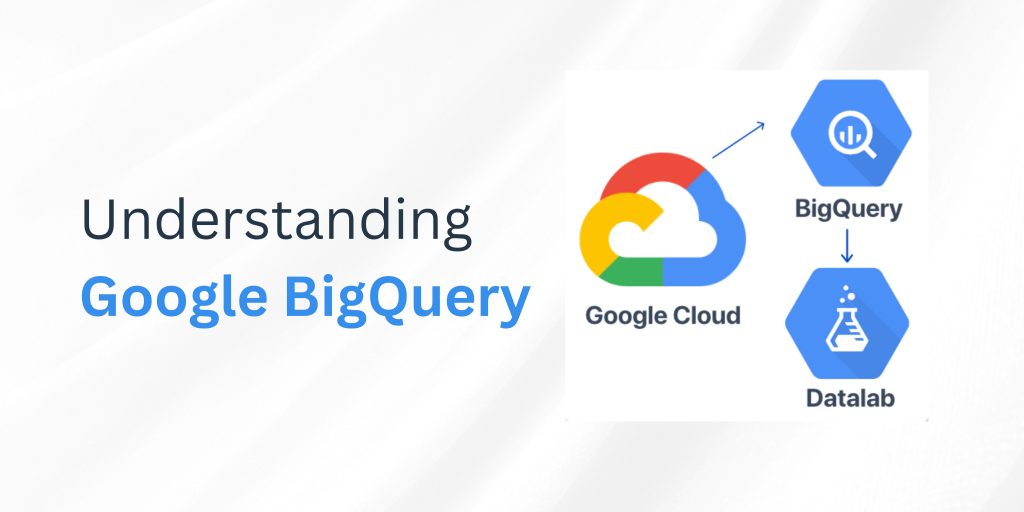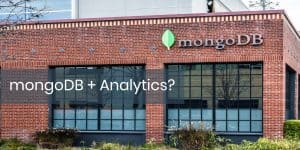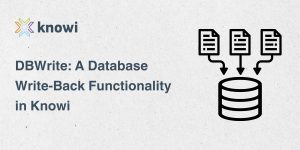Before we jump into it, if you are trying to visualize your BigQuery data, take a look at our BigQuery Analytics page. You can also set up a call with a our team to see if Knowi is a good BI solution for your use case.
BigQuery, developed by Google, stands as a flagship product in the cloud-based big data analytics domain. It’s designed to process massive datasets at incredible speeds, allowing businesses, data analysts, and engineers to find valuable insights using SQL queries. Here’s a breakdown of what BigQuery is, its architecture, and its limitations.
What Is BigQuery?
BigQuery is a fully-managed, serverless data warehouse that facilitates scalable and cost-effective data storage and analysis. It’s part of the Google Cloud Platform (GCP), offering powerful data analytics capabilities without the need for managing infrastructure. BigQuery comes with a built-in petabyte scale query engine and supports ANSI SQL and AutoML.
Architecture
BigQuery’s architecture is designed to separate storage and computation, allowing for high scalability and performance. This decoupled storage and compute allows customers to be flexible and have more control over costs. It stores data in columnar format, which enhances query performance and reduces the amount of data scanned during searches.
Source: https://cloud.google.com
- Storage: Data is stored in Google’s cloud infrastructure, ensuring high availability and durability. BigQuery automatically manages and optimizes storage, adjusting to the best performance/cost balance.
- Compute: BigQuery executes queries using a distributed computing model. When a query is run, it’s distributed across multiple servers to parallelize the processing, significantly speeding up the analysis of large datasets.
BigQuery Layers
Source: https://cloud.google.com
- Colossus
Colossus is the layer where we store data. It is actually a file system similar to Google file system. Colossus is a cluster level file system and distributed and it also maintains the replication of the data that you have stored.
BigQuery stores all its data in a column-oriented storage format, referred to as a “capacitor”. Unlike row-oriented storage, where data is stored row by row, a column-oriented storage format stores data column by column. This means that each column’s data is stored together, which can significantly improve the performance of certain types of queries, especially those that only need to access a subset of columns. The storage format is advantageous for read-heavy operations, such as analytical and aggregation queries. Column-oriented storage allows for more efficient compression since it’s easier to find and compress similar data when it’s all stored together. This can lead to significant savings in storage space and costs, as well as improved performance due to reduced I/O from reading less data off disk.
- Dremel
Dremel is a compute engine used by bigquery to process your queries. Dremel has the following components:
- Leaf Nodes: Leaf node helps to read the data from the storage i.e. Colossus.
- Mixer: Mixer is the layer where data aggregation happens.
- Root Server: Root Server coordinates these mixers and leaf nodes.
3. Jupiter
Jupiter is a high speed Super Speed network protocol which connects Dremel (compute) and Colossus (storage).
- Borg
This whole architecture is orchestrated with a component called Borg. It is a scheduler. When you trigger a query, this query execution should happen through the internal communication between the Dremel, Jupiter and Colossus. Borg ensures this internal communication.
Query Execution
Users interact with BigQuery through SQL queries, which can be run using the GCP console, command-line tool, or various client libraries. BigQuery’s Dremel technology enables it to execute queries across billions of rows in seconds.
- SQL Interface: BigQuery uses a familiar SQL syntax, allowing data analysts and engineers to use their existing SQL knowledge to perform complex data analyses.
- Job and Query Management: BigQuery handles query execution as “jobs,” allowing users to track the execution status and manage query jobs effectively.
What It’s Used For
BigQuery serves a wide range of purposes across different industries, leveraging its fast, scalable, and cost-effective data analysis capabilities.
- Data Warehousing: As a fully-managed data warehouse, BigQuery allows businesses to store and analyze their data at scale, supporting decision-making processes with real-time insights.
- Big Data Analytics: From analyzing customer behavior to predicting market trends, BigQuery enables complex analyses over large datasets, offering insights that can drive business strategies and innovations.
- Machine Learning: With BigQuery ML, users can create and execute machine learning models directly within BigQuery using SQL queries, simplifying the process of applying machine learning to their data without needing specialized expertise.
- Data Integration and Sharing: BigQuery makes it easy to share data across different departments within an organization or even with external partners, facilitating collaborative analyses and reporting.
- Real-time Analytics: Through its integration with Google Cloud’s data streaming tools like Dataflow and Pub/Sub, BigQuery supports real-time analytics, allowing businesses to react promptly to the latest trends and events.
Limitations
BigQuery, despite its many strengths, like any technology, has limitations. Here are some key ones:
- Cost: While BigQuery’s pricing model is attractive for many, it can be challenging to predict and manage costs, especially as data volume and query complexity increase. Users pay for the amount of data scanned by queries and stored, which can add up quickly without careful management.
- Query Performance: Although BigQuery is optimized for analyzing large datasets, the performance of complex queries can sometimes be slower than expected. This is particularly true for operations that require a lot of computation or data movement, like large joins or aggregations.
- Data Manipulation Limitations: BigQuery is not designed for transactional operations or heavy updates and deletions. Its strength lies in data analysis rather than transaction processing. DML (Data Manipulation Language) operations have limitations, such as a quota on the number of update, delete, and insert operations.
- Learning Curve: BigQuery’s SQL dialect and data model can require a learning curve for users not already familiar with SQL or those coming from different database management systems. Additionally, optimizing queries for performance and cost efficiency might require deeper understanding and experience.
- Limited Support for Real-Time Transactions: While BigQuery offers streaming inserts for real-time data ingestion, it is not optimized for real-time transaction processing or for use cases that require immediate consistency, like an online transaction processing (OLTP) system.
- Cold Data Retrieval Time: For data stored in the cheaper, cold storage options (like BigQuery’s long-term storage), retrieval times can be slower compared to data actively kept in the more expensive standard storage.
- Integration and Ecosystem: While BigQuery integrates well with other Google Cloud products and popular data science tools, integration with certain third-party tools or legacy systems might require additional effort or the use of intermediary services.
In summary, BigQuery democratizes big data analytics, offering powerful, accessible, and scalable data analysis capabilities. Whether it’s through real-time insights, predictive analytics, or collaborative data sharing, BigQuery provides a robust platform for leveraging data to drive business decisions and innovations.






